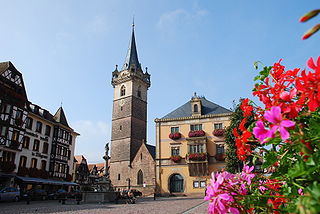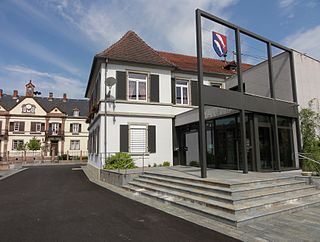
Alsace is a cultural region and a territorial collectivity in eastern France, on the west bank of the upper Rhine next to Germany and Switzerland. In 2020, it had a population of 1,898,533. Alsatian culture is characterized by a blend of Germanic and French influences.

Bas-Rhin is a department in Alsace which is a part of the Grand Est super-region of France. The name means 'Lower Rhine', referring to its lower altitude among the two French Rhine departments: it is downstream of the Haut-Rhin department. Note that both belong to the European Upper Rhine region. It is, with the Haut-Rhin, one of the two departments of the traditional Alsace region which until 1871, also included the area now known as the Territoire de Belfort. The more populous and densely populated of the pair, it had 1,140,057 inhabitants in 2019. The prefecture is based in Strasbourg. The INSEE and Post Code is 67.

Sélestat is a commune in the Grand Est region of France. An administrative division (sous-préfecture) of the Bas-Rhin department, the town lies on the Ill river, 17 kilometres (11 mi) from the Rhine and the German border. Sélestat is located between the largest communes of Alsace, Strasbourg and Mulhouse.

Choucroute garnie is an Alsatian recipe for preparing sauerkraut with sausages and other salted meats and charcuterie, and often potatoes.

Obernai commune in the Bas-Rhin department in Alsace in north-eastern France. It lies on the eastern slopes of the Vosges mountains.

Rosheim is a commune in the Bas-Rhin department in Grand Est in north-eastern France.

Schirmeck is a commune in the Bas-Rhin department in Grand Est in north-eastern France.

Huttenheim is a commune in the Bas-Rhin department in Grand Est in north-eastern France.

Andlau is a commune in the Bas-Rhin department in Alsace, Grand Est region of northeastern France.

Avolsheim is a commune in the Bas-Rhin department in the Grand Est region of north-eastern France.

Barr is a commune in the Bas-Rhin department in the Alsace region of north-eastern France.

Goxwiller is a commune in the Bas-Rhin department in Alsace in north-eastern France.

Gertwiller is a commune in the Bas-Rhin department in Alsace in north-eastern France.

Innenheim is a commune in the Bas-Rhin department in Alsace in north-eastern France.

Beinheim is a commune in the Bas-Rhin department in Grand Est in the Alsace region of northeastern France.

Grendelbruch is a commune in the Bas-Rhin department in Grand Est in north-eastern France.

Herrlisheim is a commune in the Bas-Rhin department in Grand Est in north-eastern France. The town dates from the 8th century. Herrlisheim was the scene of very heavy fighting during Operation Nordwind, an offensive launched by the German Army during World War II that inflicted considerable damage to the town.

Le Hohwald is a commune in the Bas-Rhin department in Alsace in north-eastern France.

Meistratzheim is a commune in the Bas-Rhin department in Grand Est in north-eastern France.

Ottrott is a commune in the Bas-Rhin department in Grand Est in north-eastern France. It lies southwest of Strasbourg. The vineyards in and around Ottrott produce the red Rouge d'Ottrott, a geographical denomination within the registered designation of origin Alsace AOC.

























